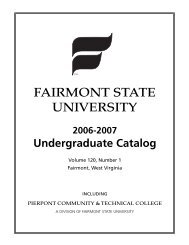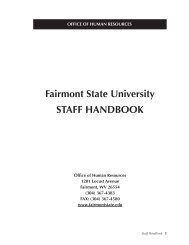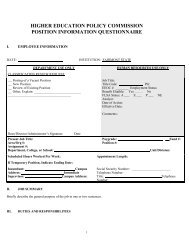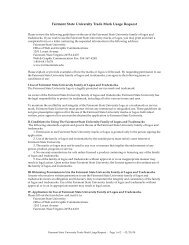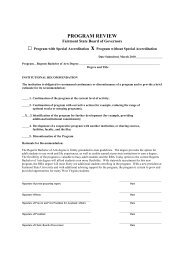Faculty Handbook - Fairmont State University
Faculty Handbook - Fairmont State University
Faculty Handbook - Fairmont State University
Create successful ePaper yourself
Turn your PDF publications into a flip-book with our unique Google optimized e-Paper software.
108<br />
<br />
<br />
Maximum credit for time in rank – 9 years<br />
Maximum target salary – 110% of CUPA base<br />
The equity adjustments will have two components, fixed and variable. The maximum<br />
possible variable percentage will be no greater than the fixed percentage and will be<br />
determined based on dollars available. The variable percentage for each individual will<br />
be determined by the difference between their OCR score and the minimal acceptable<br />
OCR score. To be eligible for an equity adjustment in any given year, a faculty member<br />
must be eligible for a merit increase.<br />
3.1.1.1. For the purpose of accelerating approach to target salary,<br />
an additional amount of money may be made available by<br />
the Board. These dollars will be dispersed as described in<br />
3.1.1.<br />
3.1.2. Merit Pay Allocations: The remaining salary increase pool after<br />
Section 3.1.1 is implemented shall be distributed on the basis of<br />
merit pay. The procedures for determining merit will be those<br />
developed by the faculty in the respective schools and colleges and<br />
approved by the Provost.<br />
Graduated Rankings of Recipients. The merit raise will have two components, fixed and<br />
variable. The maximum possible variable percentage will be no greater than the fixed<br />
percentage and will be determined based on dollars available. The variable percentage<br />
for each individual will be determined by the difference between their OCR score and<br />
the minimal acceptable OCR score. The percentage of the variable component pool<br />
available to each School or College will equal the School or College’s percentage of the<br />
total salary pool. Those rated below a minimal acceptable level as determined by the<br />
Provost in consultation with the <strong>Faculty</strong> will not receive a merit increase.<br />
SECTION 4. CLASSIFIED STAFF SALARY POLICY<br />
4.1. Salaries of classified employees shall be set consistent with Article 9, Chapter<br />
18B of the Code of West Virginia and Series 8, as amended by the Higher<br />
Education Policy Commission.<br />
4.2. In computing the salary increases for all classified employees, the target salary<br />
under the salary schedule set forth in Section 3, Article 9, Chapter 18B of the<br />
Code of West Virginia, as amended, shall be identified. The gaps between the<br />
target and current salary shall be established. Salaries of all classified employees<br />
shall be increased in equal proportions toward eliminating all gaps; however no<br />
raises will be given if the employee’s overall job performance evaluation is<br />
“unsatisfactory.” Beginning January 1, 2007, no raises will be given if the<br />
employee’s overall job performance evaluation is “needs improvement” or<br />
“unsatisfactory.”<br />
SECTION 5. NON-CLASSIFIED SALARY POLICY<br />
The total dollars for the annual increase in aggregate non-classified salaries shall be<br />
distributed among non-classified staff as follows:<br />
5.1. Salary Inequities Distributions: The President may distribute a portion of the<br />
non-classified salary increase pool at his/her discretion to address salary<br />
inequities.



